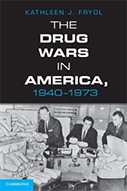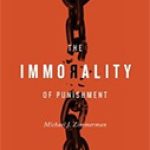The Drug Wars in America, 1940-1973

Author: Kathleen Frydl
Publisher: Cambridge, UK; New York; Cambridge University Press, 2013. 447p.
Reviewer: Paul Gootenberg | November 2013
Before any deeper analysis or criticism of this book, let me note that The Drug Wars in America, 1940-1973 is the most compelling scholarly book to date written on an important subject: America’s post-war transition to punitive domestic drug policy. It should be the standard on this topic for many years, a companion to David Weimer’s recent Seeing Drugs (2011) which concerns U.S. overseas drug warring in the years surrounding the 1973 endpoint here. The Drug Wars in America is deeply researched in the archives, richly contextualized in the newest trends of U.S. history, and provocative and complex in its analysis. Not just another critique of “drug war” ideologies, failures, and fallacies, it is necessary reading for anyone interested in the issue of reversing the prohibitionist drug regime the United States has built over the last half century. The book is also timely, given today’s crisis of mass incarceration of drug offenders, aggravated by rigid “maximum minimum” sentencing and racial policing, and the growing public and judicial disillusion with these harms. Indeed, Frydl offers an exact recipe for undoing the domestic drug wars at the book’s conclusion, with a few surprising ingredients.
Frydl argues for a “state-centered,” “state-building” or “statecraft” approach to explain the post-war drive to the over-criminalization of drug abuse in the United States. The key problem in her mind is the legal and political shift from loose regulatory anti-drug laws of the teens and 1920s, later administered by the Treasury Department’s Federal Bureau of Narcotics (1930-62), to the aggressive expansive state apparatus bequeathed by the Nixon era’s open “War on drugs,” epitomized by the 1973 formation of the bureaucratically autonomous Drug Enforcement Administration (DEA). Frydl wants us to think beyond the usually assumed racial, class, or cold-war or counter-culture explanations for escalating drug laws, instead exploring with rigor how different branches and levels of the U.S. state interacted behind the scenes to produce a working (or not-so-working) punitive regime. The documentary base, including rich use of DEA predecessor records (RG170) of the U.S. National Archives (NARA), is vast and varied, and is also grounded by a case study of evolving drug policing and treatment policies in the predominantly African-American (and federally restrained) District of Columbia.
Following a broad and sophisticated Introduction, Chapter 1, “Trade in War,” uses World War II as a watershed, as Henry Anslinger’s FBN began a course of political expansion and militarization of U.S. drug policy —perhaps not unsurprisingly, during a general process of war-led state-building. Although Anslinger has been studied (and usually mocked) by many previous historians, Frydl deals with his war-time strategies, patterned after J. Edgar Hoover’s FBI, with analytical nuance. Military discourse against drugs (for example, in delineating “illicit” vs. licit traffic itself) is less discussed, although modern wars (WWI, Korea, Vietnam included) and post-wars seem to invariably ratchet up anti-drug campaigns. Chapter 2, “Presumptions and Pretense” reveals responses to international traffic to 1960. Here we learn, for example, the strategic concerns that animated Anslinger’s office: the global culprit politics attributing illicit flows to pre-war Japan, “Red” China (the PRC ), or flamboyant mafia figures like “Lucky” Luciano, and actively downplaying the work of useful Cold-war allies such as the French or Laotian anti-Communists. The trend was to pin blame on sinister “cabals” instead of viewing drugs in a larger social or commercial universe and to assert the FBN myth of American “control.” Again, few of these themes are new to specialists, but they come together here in particularly lucid ways. A long Chapter 3 treats perceptions of domestic drug usage as “contagion” during the 1950s: concerns with crime and race in the District, the landmark Kefauver, Boggs and Daniel’s commissions and hearings, anxieties over corruption of youth and the first mandatory sentencing for drug crimes, based on a containment model. Greater public attention to drugs was, in fact, weakening Anslinger’s anachronistic hard-line triumphalism. A major subtheme here is the FBN’s relation with the FDA and other agencies about the growing abuse of barbiturates and amphetamines, still legally tolerated, and notorious, for instance, among long-distance truckers. The discussion is rich, but could have benefitted by drawing on the provocative ideas of historical-pharmacologist Richard DeGrandepre (2006), who has laid out the era’s cycles of “Angel” and Demon” drugs, and their economic and ideological underpinnings.
Chapter 4, “Review and Reform” deals with the denouement of the FBN: President Kennedy’s open skepticism of FBN leadership and his brother (Attorney General) RFK’s famous inquiry and reorganization of the agency. The Anslinger era was over, but a critical mid-60s hiatus ensued. Readers also get a vivid sense of the polyphony of voices in American politics who questioned the path to punitive drug policies. Yet, in the end, in a bureaucratic gap between the dissolved FBN and its successors (BNDD and then the DEA), punitive perspectives, as if by default, prevail. Chapter 5, “Policy and Clinics,” delves into the heady rise of urban crime politics during the 1960s, informed by the racial politics of urban neglect and reform. Rising heroin usage begat both active street-level policing responses (the proliferation of urban narcotics squads) and Richard Nixon’s mass social program of methadone maintenance clinics. The District of Columbia was a laboratory for these forces, if not host to the era’s middle-class drug “counter-culture” Frydl trivializes (CF, Targoff). The vital point is that this volatile time became the context for the era’s significant moves to newly unified federal drug legislation, the 1970 Controlled Substances Act, and for skyrocketing budgets for federal drug enforcement– from $3 million to $224 between 1968-74 alone. Frydl notes that Nixon, who established the DEA during Watergate, had already turned his “anti-crime” politics against his own clinic programs; a fact not stressed enough in journalist Michael Massing’s well-known book on the topic, The Fix (1998).
Chapter 6, “The Cost of Denial” addresses the 1960s-1970s intensification of U.S. anti-drug intervention abroad, as a paradoxical offshoot of the 1960s failures of containing drugs at home. The author analyzes with revisionism the drug hysteria surrounding Vietnam War combatants and the early ant-drug campaigns (“Cooperation” “Intercept”) waged in Turkey and Mexico. By the early 1970s, the elements of a full-fledged drug war were in place: punitive federal and state legislation, newly centralized agencies of control, budgetary expansion, global to local policing, the naturalized curtailment of civil liberties, and rising drugs like South American cocaine, to fuel later punitive drives.
The Conclusion reasserts the primacy of “state-craft” or “state power” to explain the persistent half-century of drug war failure, but also uses that historical argument to inform a constructive set of policy recommendations. Frydl advocates full legalization of marijuana; universal treatment options; abolition of the DEA (and ONDCP?) to return to Treasury Department and presumably FDA management of illicit drugs, enhanced funding of local policing, and explicit buy-up programs for foreign drug crops. She also warns, as many do, of the dangerous precedents set by the twentieth-century drug war for the twenty-first century global “War on Terror.”
Although greatly impressed by the depth of research and ideas of this book, I was not fully convinced by certain arguments. The meaning of a state-centered or state-craft interpretation is not clearly specified. Since our nation’s drug policies seem to most academics, on face value, to be so foolish, unjust, and counter-productive, it is always tempting to assume they are a stand -in about something else. Hence, historians suggest ideas about punitive or cultish ideologies, racism or class conflict, urban crises, corporate economic gain, U.S. imperialism, or the cultural politics of modernity or gender in the origins of prohibition thought. Yet, in evoking “the state,” is Frydl talking mainly about “bureaucratic” turf and budgetary politics; a kind of post-New Deal federal mission creep; a Weberian or Hintzean ideal of shifting legal-social regimes; or a Foucaudian notion of “governmentality” as subject-producing social control? All of these are hinted yet underdeveloped as a line of analysis.
The book’s clearest statist model —fiscality—is the weakest, in my view. Frydl stresses that the 1914 Harrison Act was formally a tax and revenue act, and until the 1960s, federal drug control enforcement fell under the rubric of the Treasury Department, not Justice. (Federal drug policy today is conducted by a cacophony of competing agencies, in theory overseen by the 1980s era ONDCP, i.e., the “President’s” Drug Czars’ office). The ever-more punitive thrust of post-1950 drug laws, in Frydl’s view, was part and parcel of the gradual abandonment of an earlier “regulatory” taxation framework. This is an unusual even radical argument, especially that the United States had a prior and presumably better regulatory system.
That interpretation, however, remains thinly substantiated. It defies evidence deployed by classic historians of drugs, such as David F. Musto, that the intent of Harrison, the Miller-Jones Act and a host of other initial drug legislation—Treasury jurisdiction and evasive strategies of constitutionality aside—was “prohibition.” This was revealed in concerted early 1920s federal persecution campaigns against doctors who attempted to institute a more liberal or humane application of law to addicts— a “medicalization” or drug maintenance approach, which in sharp contrast prevailed in Britain. Anslinger built on this prohibitionist spirit, more so once the anti-alcohol edifice of the crusade collapsed in the early 1930s. Moreover, there is no actual fiscal evidence marshaled here that a “tax for regulation” compact existed: how much revenue was generated by taxes or stamps on heroin or cocaine or later cannabis? None, as far as I saw; for it was never allowed to operate that way. In state-building a la fiscal institutionalism of North and Thomas (1976), or the classic drug revenue for social toleration trade-off (i.e., tobacco and alcohol as conceived by global drug historian David T. Courtwright, 2001), the money trail is critical.
Rather than cannabis “stamps” in the market, there’s a counter-explanation. A material federal compact likely existed at the level of a small number of pharmaceutical companies (by the 1930s, basically reduced to Merck of New Jersey and Mallinckrodt for cocaine and morphine). It obeyed the Progressive ideal of corporate-state self-regulation. By the 1920s, after a sorting out process, such privileged companies centralized, policed, reduced, and controlled the import, refining, and distribution of “narcotics.” The revenue pool for the federal Treasury proved minuscule, much less from retail practitioners such as pharmacists and dentists. However, the payoff in terms of cooperation, transparency, and containment proved incalculable for drug control. For a few decades (the 1920s-60s, approximately), this compact successfully squeezed the spigot of dangerous drugs into the domestic market, as I suggested for cocaine in my 2009 book, Andean Cocaine: The Making of a Global Drug (Ch. 5). This model extends the corporate pharma progressivism found in Joseph Spillane’s superb study (2000) of cocaine’s business culture and criminalization in the turn-of-century United States. Indeed, I was struck by how little Frydl cites works about the departure point of the early twentieth-century drug regimes, not to mention largely orphaned (and at times, factually mangled) drugs like cocaine.
The “statecraft” theory is not wrong per se, but I think is mis- or unspecified by the forced notion of a prior fiscal-regulatory regime. The book supports statist moves on a variety of other political levels (McCarthyism, the new urban crisis, policing strategies, etc.) that hammered home to post-war politicians and the public the “contagion” of the criminalization model.
By the 1980s, the institutional apparatus of the state—an awkwardly named “incarceration-drugs-industrial complex”—had indeed become an inexorable material reality, a monster arising out of the Reaganesque neo-liberal combination of downsizing of the state with outsized repression. As Michelle Alexander and others have forcefully shown, local policing throughout the land, for example, became reliant on drug-war revenue streams, including liberty-trampling confiscations of “dealer” assets and property. Today’s drug reformers, including likely some high-level elected officials, regard these unaccountable drug war revenue “state” interests as the entrenched obstacle to reform. Our challenge is no longer public anxiety of drug crime, which seems much softer, for example, in today’s vibrant movements for just sentencing and “medical” marihuana.
Finally, and at the risk of reviewing a book from a “what it should have done” perch, I picked up a narrative in The Drug Wars in America that merited more space, perhaps, than fiscal politics. I wish it had foregrounded and analyzed the rich line of actors who provided a historical counter-narrative to punitive criminalization. At every stage of the escalation of post-war U.S. drug control, voices of reformers—legal, medical, diplomatic, commercial, policing–were heard, arguing strenuously, even heroically, to end the increasingly unjust and unworkable punitive model . Some are famous names, others not, including Indiana University sociologist Alfred Lindesmith, Los Angeles Police Chief August Vollmer, New York Judge Jonah Goldstein, legal scholar Rufus King, academic David Goddard, California Congressman Don Edwards, even Attorney General Kennedy and his anointed reformer Barrett Prettyman Jr. There was, it seems, serious, articulate, sustained opposition to the punitive march. These dissidents seem at times in the text to shift the terms of debate, so a good question is why they failed to ultimately prevent the march to hyper-criminalization. Was it a simple lack of constituency or organization, something today’s drug reform movement (finally a movement) seems to have overcome? Or that iron force of “statecraft”?
All that said, let me reiterate that The Drug Wars in America, 1940-1973 is the best book I’ve read on this critical subject, and a major contribution to the scholarship on the political and legal history of drug policies in the United States.
REFERENCES:
Courtwright, David T. Forces of Habit: Drugs and the Making of the Modern World. Cambridge: Harvard University Press, 2001,
DeGrandepre, Richard, The Cult of Pharmacology: How America Became the World’s Most Troubled Drug Culture. Durham: Duke University Press, 2006.
Gootenberg, Paul, Andean Cocaine: The Making of a Global Drug. Chapel Hill: University of North Carolina Press, 2009.
Massing Michael, The Fix: Under the Nixon Administration, America Had an Effective Drug Policy. We Should Restore It. New York: Simon & Schuster, 1998.
Musto, David F. MD., The American Disease: Origins of Narcotic Control (New Haven: Yale University Press, 1973, rev. ed. 1987.
North, Douglass C. and Robert P. Thomas, The Rise of the Western World: A New Economic History. Cambridge: Cambridge University Press, 1976.
Spillane, Joseph F. Cocaine: From Medical Marvel to Modern Menace in the United States, 1884-1920. Baltimore: Johns Hopkins University Press, 2000.
Targoff, Martin. Can’t Find My Way Home: America in the Great Stoned Age, 1945-2000. New York: Simon & Schuster, 2004.
Weimer, David. Seeing Drugs: Modernization, Counterinsurgency, and U.S. Narcotics Control in the Third World, 1969-1976. Kent OH: Kent University Press, 2011.
Paul Gootenberg, SUNY Distinguished Professor of History & Sociology, Stony Brook University


